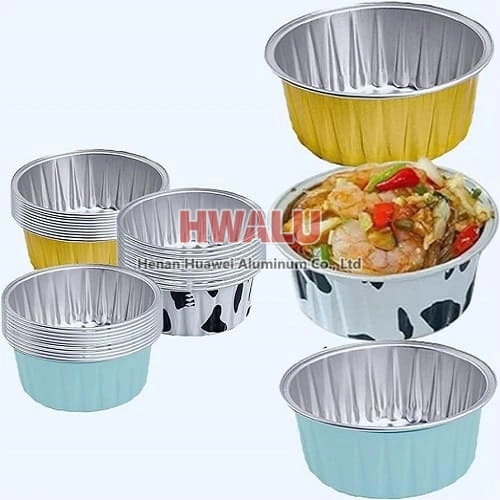PTP aluminum Blister foil parameter Alloy 1235, 8011, 8021 etc Temper O( HO ), H18, etc Width 300mm, 600mm, etc Thickness OP: 0.5 - 1.5 g/m2 Aluminum foil: 20 micron ( 0.02mm ), 25 micron ( 0.025mm ), 30 micron ( 0.3mm ) etc HSL ( VC ):3 - 4.5 gsm Primer: 1gsm Surface treatment Laminated, printing, Single bright side, etc What is ptp aluminum blister foil ...
What is aluminum foil for cable? The outer surface of the cable needs to be wrapped with a layer of aluminum foil for protection and shielding. This kind of aluminum foil is usually made of 1145 grade industrial pure aluminum. After continuous casting and rolling, cold rolling, slitting and complete annealing, it is divided into small coils according to the length required by the user and supplied to the cable f ...
What is aluminum foil for cake cup? Aluminum foil can be used for many purposes in baking, such as making cupcake cups or liners. Aluminum foil cake cups are cup-shaped containers used for baking cakes, cupcakes, or cupcakes, usually made of aluminum foil. Cake cup aluminum foil is used to wrap the bottom and sides of the cake cup to maintain the shape of the cake when baking, prevent sticking, and make the ca ...
Baking food aluminum foil roll Aluminum foil is a product with a very wide range of uses. According to the use of aluminum foil, it can be divided into industrial aluminum foil and domestic aluminum foil. Baking food aluminum foil roll is aluminum foil for daily use. Aluminum foil is widely used in daily life, such as the production of aluminum foil lunch boxes, food packaging, pharmaceutical packaging, etc. ...
Aluminum foil for packaging bag introduction Aluminum foil bags are also called aluminum foil bags or aluminum foil packaging bags. Because aluminum foil has excellent barrier properties and protective capabilities, it is widely used to package a variety of products. These foil bags are commonly used to preserve the freshness, flavor and quality of food, pharmaceuticals, chemicals and other sensitive items. ...
What is aluminum foil for pharmaceutical packaging Aluminum foil for pharmaceutical packaging is usually composed of aluminum foil, plastic film, and a glue layer. Aluminium foil has many advantages as a packaging material, such as moisture-proof, anti-oxidation and anti-ultraviolet properties, and can effectively protect medicines from light, oxygen, and moisture. Aluminium foil for pharmaceutical packaging ...
Degreasing pollution is mainly manifested on the surface of the aluminum foil in 0 state. After the aluminum foil is annealed, it is tested by the water brushing method, and it does not reach the level specified in the water brushing test. The aluminum foil that requires the water-washing test is mainly used for printing, composite with other materials, etc. Therefore, the surface of the aluminum foil must be ...
In the production of double foil, the rolling of aluminum foil is divided into three processes: rough rolling, intermediate rolling, and finishing rolling. From a technological point of view, it can be roughly divided from the thickness of the rolling exit. The general method is that the exit thickness is greater than Or equal to 0.05mm is rough rolling, the exit thickness is between 0.013 and 0.05 is intermediat ...
The main alloying elements of 6063 aluminum alloy are magnesium and silicon. It has excellent machining performance, excellent weldability, extrudability, and electroplating performance, good corrosion resistance, toughness, easy polishing, coating, and excellent anodizing effect. It is a typically extruded alloy widely used in construction profiles, irrigation pipes, pipes, poles and vehicle fences, furniture ...
Product name: industrial aluminum foil roll Item Specification (mm) Description ALUMINUM FOIL ROLLS WITH SUPPORT FOR INDUSTRIAL USE 8011-O, 0. 014 (+/-4%) *300 (+/-1mm). Outside -matt Inside - bright ID 152 OD min 450, Max 600. Elongation - min 2% Tensile strength - min 80, max 130MPa. Porosity - max 30 pcs per 1m2. Wettability - A. Splices - maximum 1 splice per ...
Aluminum foil lunch boxes made of aluminum foil can be processed into various shapes and are widely used in food packaging such as pastry baking, airline catering, takeaway, cooked food, instant noodles, instant lunch and other food fields. The aluminum foil lunch box has a clean appearance and good thermal conductivity. It can be heated directly on the original packaging with ovens, microwave ovens, steamers and ...
For the capsule shell, because it is made of aluminum, aluminum is an infinitely recyclable material. Capsule coffee generally uses an aluminum casing. Aluminum is the most protective material at present. It can not only lock the aroma of coffee, but also is light in weight and high in strength. At the same time, aluminum protects the coffee from foreign substances such as oxygen, moisture and light. For cof ...








